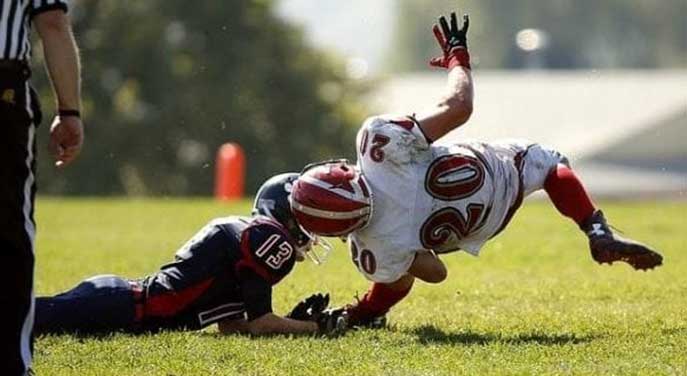 The fact Miami Dolphins quarterback Tua Tagovailoa was allowed to return to a game against the Buffalo Bills after clearly suffering a concussion is terrible. The fact he was allowed to play four days later in a Thursday night game against the Cincinnati Bengals, in which he sustained a second concussion, is worse.
The fact Miami Dolphins quarterback Tua Tagovailoa was allowed to return to a game against the Buffalo Bills after clearly suffering a concussion is terrible. The fact he was allowed to play four days later in a Thursday night game against the Cincinnati Bengals, in which he sustained a second concussion, is worse.
And it could’ve been tragic.
People who suffer a second concussion shortly after a first one are at risk for Second Impact Syndrome (SIS), which can have devastating consequences, including death.
I regularly criticize the NFL and NCAA for their lax approach to brain injuries. I want all college and pro football players and coaches to be fully educated about the dangers to the brain that tackle football represents, how to lessen the chances of brain injuries, and how to quickly identify them when they occur.
 |
| Related Stories |
| Concussions affect elite athletes’ mental health, new research suggests
|
| Head injuries and football go hand in hand
|
| There’s no such thing as a concussion-safe football helmet |
But my biggest concern is the millions of kids who play tackle football at the youth and high school levels, many of them without a doctor or trainer on the sidelines during games and/or practices.
Brain injuries and chronic traumatic encephalopathy (CTE) cases involving adults playing in the NFL get almost all the media attention in the U.S. But brain injuries are also happening every week at high school and youth levels, and – relatively speaking – that fact receives scant coverage.
Just a couple weeks before the Tua Tagovailoa incident, a New Jersey high school football player died from a traumatic brain injury suffered during a game. How many of you were aware of that?
CTE isn’t just an NFL issue. Boston University’s CTE Center discovered CTE in the brains of 110 of 111 former NFL players. That finding got headlines across the country. But the Center also found CTE in the brains of 48 of 53 former college players, none of whom went on to play professionally.
In addition, 21 percent of the 14 brains of former high school football players studied at the Center had evidence of CTE. And those players never played a single game of football beyond high school.
Unlike NFL players, children play football while their brains are still developing, increasing the risk of serious brain injuries. These kids are allowed on football fields by their parents/guardians before they reach the age of legal consent – and before they are capable of fully understanding the short- and long-term risks football represents to their young brains.
According to the Brain Injury Research Institute, in any given season, 20 percent of high school players sustain brain injuries. Additionally, over 40.5 percent of high school athletes who have suffered concussions return to action prematurely, which can lead to death from the aforementioned Second Impact Syndrome, a condition in which the brain swells, shutting down the brain stem and resulting in respiratory failure.
It’s important to be aware that it’s not just concussions we’re concerned about today. Purdue researchers compared changes in the brains of high school football players who had suffered concussions during a given season with the brains of football players who were concussion-free and found brain tissue damage in both. That means brain injuries occur from playing football without players, coaches or parents even being aware of it.
According to research published in the Journal of Athletic Training, 55 percent of high school athletes said they didn’t or wouldn’t report a concussion. Reasons for not reporting the concussion symptoms included: not wanting to lose playing time, not thinking the injury was severe enough to require medical attention, and not wanting to let the team down.
Another disturbing finding from the U.S.: Only 37 percent of U.S. high schools employ a full-time athletic trainer. That’s important because schools with full-time trainers do a better job of identifying concussed athletes than schools without full-time trainers. Also, athletes at schools without full-time athletic trainers dangerously return to play sooner than athletes with full-time trainers. Moreover, athletes at schools with athletic trainers correctly identified the signs and symptoms of concussions at a higher rate than athletes at schools without full-time trainers.
One thing’s for sure: If schools are going to spend money to fund football and other contact sports, they also need to find the money to fund a full-time athletic trainer who is nearby for practices and games and, ideally, a doctor who’s on the sideline for games.
Ken Reed is sports policy director for League of Fans (leagueoffans.org), a sports reform project. He is the author of The Sports Reformers, Ego vs. Soul in Sports, and How We Can Save Sports.
For interview requests, click here.
The opinions expressed by our columnists and contributors are theirs alone and do not inherently or expressly reflect the views of our publication.
© Troy Media
Troy Media is an editorial content provider to media outlets and its own hosted community news outlets across Canada.

